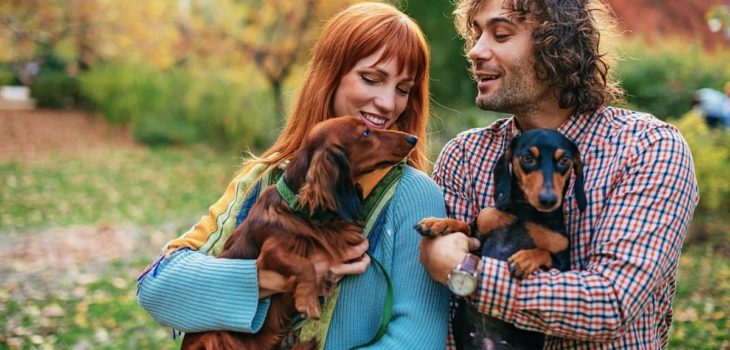Dachshunds can be very affectionate pets, to the point of easily getting jealous of other dogs. So, here’s some info on introducing a second dachshund – 6 crucial tips. We’ll cover the main steps every Doxie owner should follow if they want to get a second dog as well as why Doxies can be so obstinant at times.
Introducing A Second Dachshund To Your Pet – What’s The Secret?
The process of bringing a second dog home is simple but it should be followed carefully. In a way, introducing a second dachshund it’s not dissimilar to introducing two cats to each other. Here’s what you want to do:
- First, before you even pick a second dog, it’s vital that you socialize your first dog well. This means getting your dog used to meeting and interacting with other people, dogs, and animals frequently, as well as both outside and at home. It’s important that your dachshund perceives other animals and people as friendly sources of fun and not as potential threats.

Learn more about: Corgi Wiener Dog Mix – A Loyal and Playful Family Pet
- Once you’ve got a well-socialized dachshund, it’s time for the first meet-up. This should be done outside, at a fun, familiar, and safe location like the dog park. Let the two dogs get to know each other and become friends that way first. Repeat this step several times if needed.
- Next, when you bring the second dog home, make sure your first pooch isn’t around. It can either be on a long walk/hike outside or in a separate part of your home. If you’re isolating your first dog, make sure it’s not in too tight of a place and that there’s a family member there – you don’t want your first dog to feel punished or restricted.
- Keep the two dogs separated for a while – from several hours to a day or so – until your first dog gets familiar with its new home. It’s ok for the two dogs to sniff each other through the door that divides them and to communicate. Just make sure that there’s a person with each of them to give them comfort and attention. Feed them and play with them simultaneously and on both sides of the dividing door.
- After several hours or a day, change the locations of both dogs. Let them explore and sniff around freely until they feel comfortable. Repeat this step a couple more times if needed.
- Once you’re calm the dogs aren’t aggressive with each other, you can unite the two halves of your home and let the two be reintroduced officially.
That’s pretty much how introducing a second dachshund works.
In Conclusion, What’s The Secret To Introducing A Second Dachshund Into Your Home?
The keyword here, as with any other breed, is socialization. If you’re ever planning to get a second dog or if you just want your Doxie to be well-behaved around others, it’s important to socialize it with people, dogs, and other animals from an early age. From there, it’s just a matter of introducing a second dachshund slowly, strategically, tactfully, and with lots of patience, love, and attention given to both animals.
Read more about: Do Dachshunds Like Other Dogs And 15 Breeds That Get Along With Them
FAQs
[rank_math_rich_snippet id=”s-ada12739-526e-49a1-8b5c-e90258905181″]




